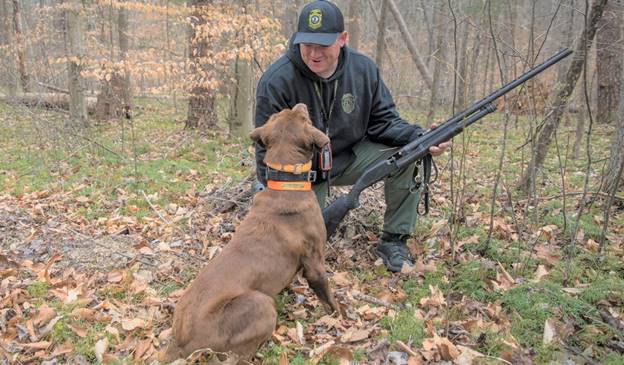
Photo by Meghan Marchetti – CPO Ian Ostlund rewards Reese after she successfully found a gun in the woods on an article search exercise.
The five dogs in training to become K9 Conservation Police Officers with the Virginia Department of Game and Inland Fisheries (DGIF) continued their education with a session before restrictions due to the COVID-19 outbreak tightened.
The dogs and their handlers moved on to work on searching for articles and detecting wildlife in addition to continuing to hone their basic obedience and person-tracking skills. The different personalities of the dogs are becoming even more obvious, and the handlers are learning what approach to training works for their individual dog.
The DGIF K9 program is supported by the Ward Burton Wildlife Foundation (WBWF). You can help by donating to the Caring for the CPO K9s Fund through WBWF. Your donation will go to veterinary care, maintenance costs, and training for the K9 CPOs.
Searching for items such as guns, shell casings, and articles of clothing is an essential skill for the K9 officers, as they can quickly and effectively locate evidence of a crime. They also learn to detect the presence of wild turkey and deer meat and fish in order to help enforce wildlife laws. While those two skills still use their acute sense of smell, they also differ from tracking a person in many ways. So, just as they have a harness that they wear while tracking, they also have specific collars that they wear while article searching and detecting wildlife.
Both collars go on with a distinctive click of a snap to signal the dog while the handler uses a specific command, like “search” and “find it.” The dogs learn to identify what kind of search they’re expected to do by the collar and the command. When they find the article or wildlife, they’re trained to sit or lay down and stay still, alerting to the location, until the handler rewards them.
Master SPO Mark Diluigi noted that Lily, with her methodical approach, did well with learning article searches and wildlife detection. “She gets excited when she starts article searches,” he said. “We’re working on recall so she comes when she’s called, and that she changes direction when the command is given. I’m comfortable with what we’ve learned so far; she’s confident.”
Diluigi emphasized that the handlers are very aware of the need to keep training fun for the dogs. “They’re like kids doing math homework; if you pound the work into them for two hours, they’re not going to get it,” he said. “You have to keep track of how much time you’re working with them, so they don’t get bored or frustrated. You mix up the easy and hard things to keep them interested and confident.”
Bruno is one of the younger dogs in the training, and CPO Tyler Blanks is pleased with his progression through the new skills. “Wildlife detection was entertaining for the first few days but he got the hang of it,” Blanks said. “We began by searching an indoor facility with no distractions. The scent items were hidden in concrete blocks and big plastic containers. Bruno would knock over the blocks like they were there for him to play with. I’d say he was the class clown for the first part of detection training, but pulled himself together during the last week. He did great searching vehicles and buildings with several distractions.
“I am proud of Bruno’s development in the training,” Blanks continued. “Some days are better than others but I am always able to see his progression. The training makes me excited to apply what we have learned to the field.”
CPO Ian Ostlund had to work through a few challenges with Reese, his canine partner, as well. A big, powerful chocolate Lab, Reese is well-suited to tracking a person over longer distances or find an article in a large field or in the woods. “There’s a method to how she runs through the woods; I help to guide her in the area search, but she gets to run free off-lead and work fast,” Ostlund said. “She loves it; it’s a big game for her. She gets really excited about finding an item.”
Working in the more controlled environment of wildlife detection indoors or in a vehicle was more difficult for Reese. She tended to want to bolt forward when Ostlund gave her a command, rather than work steadily. “One of the things I tried to do was speak to her in a lower, calmer voice,” he said. “I wanted her to be a little more mellow when she started that search, because you want the dog to be a bit more methodical in that search and make sure they hit all the areas. After a while, she definitely understood the game. I think she’s a very intelligent dog, but her drive is so high. That’s the one thing that I have to try to rein in at times.”
The K9s and handlers will complete a third session of training before their graduation and badge ceremony, which will take place at a date to be determined, depending on social distancing restrictions. Tsupport the K9s as they continue to learn, donate to the Caring for the CPO K9s Fund through the Ward Burton Wildlife Foundation to help them achieve their goals and to protect Virginia’s people and wildlife.

